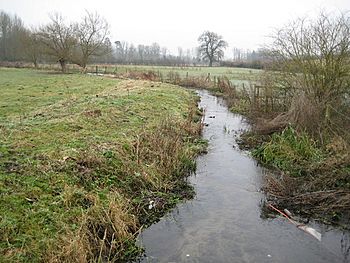River Misbourne facts for kids
Quick facts for kids River Misbourne |
|
|---|---|

River Misbourne near Chalfont St Giles
|
|
| Country | England |
| Physical characteristics | |
| Main source | Great Missenden, Buckinghamshire 129m 51°42′36″N 0°42′44″W / 51.71000°N 0.71222°W |
| River mouth | River Colne near Denham 34m 51°33′43″N 0°29′01″W / 51.56194°N 0.48361°W |
| Length | 27km (16.8 miles) |
| Basin features | |
| River system | Thames |
The River Misbourne is a river in Buckinghamshire, England. It starts in a field near Great Missenden. The river flows for about 17 miles (27 km) through several towns. These include Little Missenden, Old Amersham, Chalfont St Giles, and Chalfont St Peter. It even goes under the Chiltern railway line and the M25 motorway. Finally, the Misbourne joins the River Colne near Denham. From its start to its end, the river drops about 310 feet (94 meters).
Contents
What Does the Name "Misbourne" Mean?
The name Misbourne was first written down in 1407 as Misseburne. The part -bourne comes from an old English word, burna, which means 'stream' or 'river'.
However, the first part of the name, Mis-, is a bit of a mystery. It's also found in the names of Great Missenden and Little Missenden. Some experts thought it might come from an old Anglo-Saxon person's name.
Other researchers believe it comes from an old English word linked to 'moss'. It might also be related to Danish and Swedish words for water plants. So, the name Misbourne could mean 'river where water-plants grow'.
How Has the River Misbourne Changed Over Time?
The River Misbourne has seen some big changes because of human construction.
In 1906, the Great Western Railway built the Chalfont Viaduct. This bridge was made to carry trains between London and High Wycombe over the river.
Later, in the mid-1980s, the M25 motorway was built. The Misbourne river had to be moved. It was sent through underground concrete tunnels, called culverts, beneath the motorway. The motorway was then built to pass right through the arches of the old Chalfont Viaduct.
Why Does the River Misbourne Sometimes Disappear?
The River Misbourne is a special type of stream called a 'perch' stream. This means it flows over a layer of material that water cannot easily pass through. This layer sits on top of a porous material, like chalk, that can soak up water.
Sometimes, if there isn't much rain, the underground water level (called the water table) drops. If this happens, and the riverbed gets damaged, the river's water can sink into the ground and disappear!
The Misbourne has sometimes had less water or even stopped flowing. This is often because water companies take water from the underground sources that feed the river. When the water company tried to fix this and bring the flow back, it sometimes caused flooding in nearby towns.
After more work, the river's path was made better. For example, the upper part of the river was completely dry for over three years, starting in 2003. But it reappeared in 2007 after many months of heavy rain. This rain helped to raise the water table again.
Images for kids



